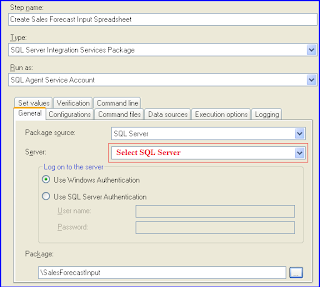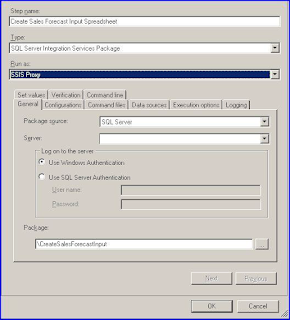We have the following ways to execute SSIS packages:
DTExec Command Line Utility
SQL Server provides the command line tool DTExec.exe which can be used to execute an SSIS package. DTExec can be run from a Command Prompt or from a batch (.BAT) file.
To begin, open a Command Prompt and navigate to the project folder as shown below (I am taking an example of SalesForcastInput package from local directory "D:\SSIS\Hari\Sample\SSIS-Sample1\SalesForcastInput.dtsx"):
Now type the following command to execute the SalesForecastInput.dtsx package:
DTEXEC /FILE SalesForecastInput.dtsx
To see the complete list of command line options for DTEXEC, type following:
DTEXEC /?
It is not necessary to navigate command prompt to package directory before executing DTExec command; You can give the full path of your package as shown below:
DTExec /f "D:\SSIS\Hari\Sample\SSIS-Sample1\SalesForcastInput.dtsx" /conf "D:\SSIS\Hari\Sample\SSIS-Sample1\SalesForcastInput.dtsConfig" /M -1
Here, /f (/File) parameter used to load the package that is saved in the file system in your system. Likewise, /conf (/ConfigFile) parameter used to load the configuration file that is saved in the file system in your system. /M (/MaxConcurrent) specifies the number of executable files that the package can run concurrently.
Click here for more information about DTExec utility and it's parameters.
DTExecUI Windows Application
SQL Server includes the Windows application DTExecUI.exe which can be used to execute an SSIS package. DTExecUI provides a graphical user interface that can be used to specify the various options to be set when executing an SSIS package. You can launch DTEXECUI by double-clicking on an SSIS package file (.dtsx).
To begin, navigate to the your project folder. Double-click on the package (For instance, SalesForecastInput.dtsx in my example) and you will see the following multi-page dialog displayed:
As you can see there are many settings available when you use this utility. As a general rule you can simply click the Execute button to run your package. You can also fine tune your execution by clicking through the various screens and entering your own settings. After changing the settings click on Command Line which will show you the DTExec command line based on the settings you have chosen.
Note: If you have a configuration file which is not configured at package level, then do not forget to add the configuration file through Configurations setting.
Scheduling SSIS Package through SQL Server Agent
SQL Server Agent includes the SQL Server Integration Services Package job step type which allows you to execute an SSIS package in a SQL Server Agent job step. This can be especially handy as it allows you to schedule the execution of SSIS package so that it runs without any user interaction.
To begin, open SQL Server Management Studio (SSMS), connect to the Database Engine, and drill down to the SQL Server Agent node in the Object Explorer. Right click on the Jobs node and select New Job from the popup menu. Go to the Steps page, click New, and fill in the dialog as shown below:


- DTExec Command Line Utility
- DTExecUI Windows Application
- SQL Server Agent
DTExec Command Line Utility
SQL Server provides the command line tool DTExec.exe which can be used to execute an SSIS package. DTExec can be run from a Command Prompt or from a batch (.BAT) file.
To begin, open a Command Prompt and navigate to the project folder as shown below (I am taking an example of SalesForcastInput package from local directory "D:\SSIS\Hari\Sample\SSIS-Sample1\SalesForcastInput.dtsx"):
Now type the following command to execute the SalesForecastInput.dtsx package:
DTEXEC /FILE SalesForecastInput.dtsx
To see the complete list of command line options for DTEXEC, type following:
DTEXEC /?
It is not necessary to navigate command prompt to package directory before executing DTExec command; You can give the full path of your package as shown below:
DTExec /f "D:\SSIS\Hari\Sample\SSIS-Sample1\SalesForcastInput.dtsx" /conf "D:\SSIS\Hari\Sample\SSIS-Sample1\SalesForcastInput.dtsConfig" /M -1
Here, /f (/File) parameter used to load the package that is saved in the file system in your system. Likewise, /conf (/ConfigFile) parameter used to load the configuration file that is saved in the file system in your system. /M (/MaxConcurrent) specifies the number of executable files that the package can run concurrently.
Click here for more information about DTExec utility and it's parameters.
DTExecUI Windows Application
SQL Server includes the Windows application DTExecUI.exe which can be used to execute an SSIS package. DTExecUI provides a graphical user interface that can be used to specify the various options to be set when executing an SSIS package. You can launch DTEXECUI by double-clicking on an SSIS package file (.dtsx).
To begin, navigate to the your project folder. Double-click on the package (For instance, SalesForecastInput.dtsx in my example) and you will see the following multi-page dialog displayed:
As you can see there are many settings available when you use this utility. As a general rule you can simply click the Execute button to run your package. You can also fine tune your execution by clicking through the various screens and entering your own settings. After changing the settings click on Command Line which will show you the DTExec command line based on the settings you have chosen.
Note: If you have a configuration file which is not configured at package level, then do not forget to add the configuration file through Configurations setting.
Scheduling SSIS Package through SQL Server Agent
SQL Server Agent includes the SQL Server Integration Services Package job step type which allows you to execute an SSIS package in a SQL Server Agent job step. This can be especially handy as it allows you to schedule the execution of SSIS package so that it runs without any user interaction.
To begin, open SQL Server Management Studio (SSMS), connect to the Database Engine, and drill down to the SQL Server Agent node in the Object Explorer. Right click on the Jobs node and select New Job from the popup menu. Go to the Steps page, click New, and fill in the dialog as shown below:

In the above example, the SSIS package to be executed is deployed to SQL Server (i.e. the MSDB database). You can also execute packages deployed to the file system or the SSIS package store.
Note that the Run as setting is the SQL Agent Service Account. This is the default setting although from a security standpoint it may not be what you want. You can setup a Proxy that allows you to give a particular credential permission to execute an SSIS package from a SQL Server Agent job step.


